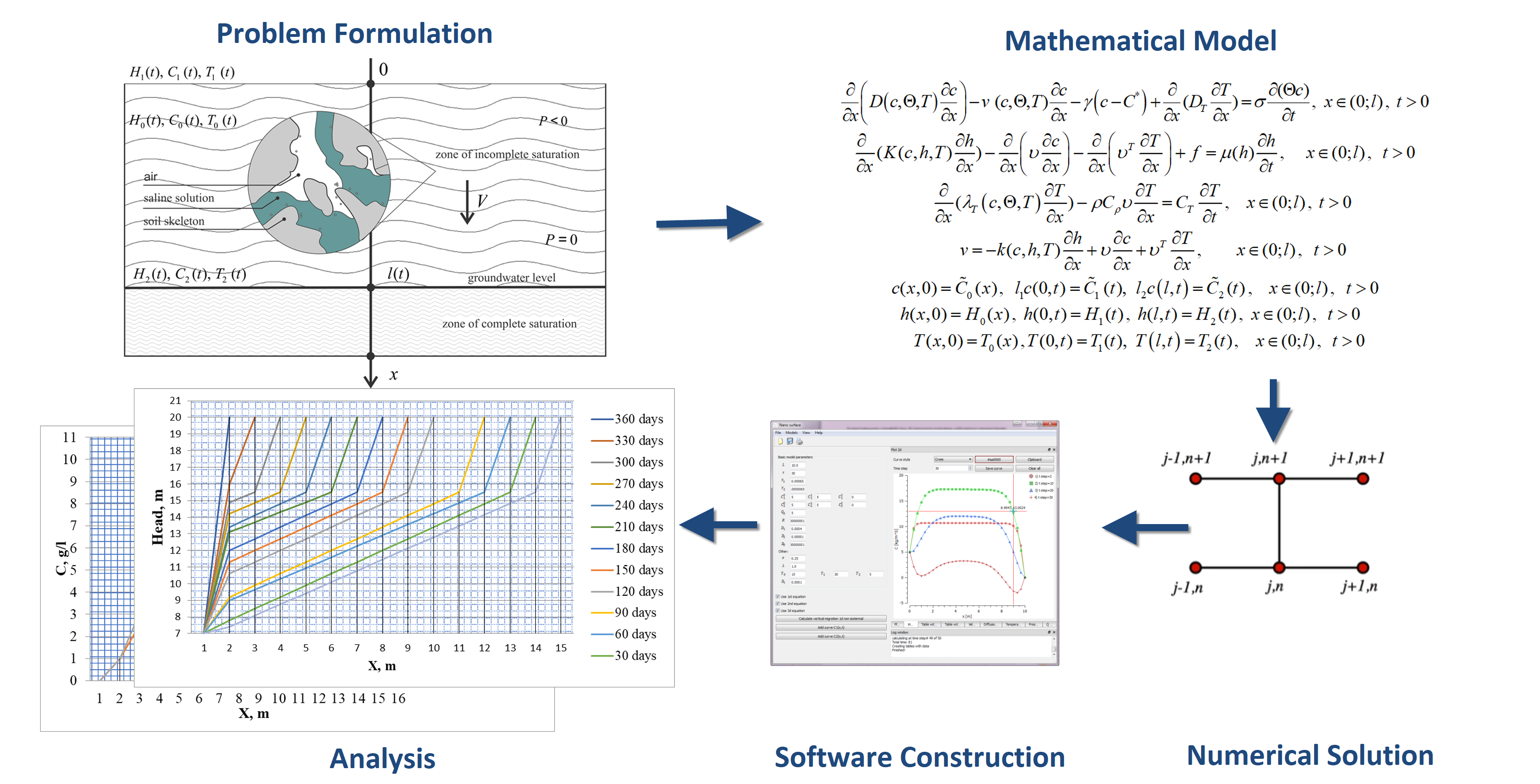Розробка математичної моделі та чисельне дослідження взаємовпливу процесів волого- тепло- масоперенесення сольових розчинів у ненасиченому шарі ґрунту
DOI:
https://doi.org/10.15587/1729-4061.2022.265809Ключові слова:
волого- тепло- і масоперенесення, зона аерації (неповного насичення), метод скінченних різницьАнотація
Методами математичного та комп’ютерного моделювання досліджено вплив взаємозв’язаних процесів перенесення сольових розчинів у ненасиченому шарі ґрунту. З цією метою розроблено математичну модель для моделювання відповідних процесів волого- тепло- і масоперенесення сольових розчинів у ненасиченому шарі ґрунту. Побудовано ефективний обчислювальний алгоритм чисельного розв’язання відповідної нелінійної крайової задачі методом скінченних різниць та виконано програмну реалізацію в середовищі програмування Asp.net на мові С++. На основі проведених чисельних експериментів отримано розподіл полів вологи, концентрації та температури в зоні аерації (неповного насичення). Для дослідження впливу масоперенесення солей на вологоперенесення знайдено чисельний розв’язок задачі вологоперенесення, задачі вологоперенесення з врахуванням масоперенесення та вологоперенесення з врахуванням масоперенесення при наявності осмосу. Аналіз отриманих результатів показав, що розподіл концентрації сольових розчинів з часом є більш повільним і прогнозованим. Встановлено, що розподіл напорів вологи зростає з глибиною та часом при потраплянні сольових розчинів на поверхню ґрунтового масиву. З впливом концентрації солей розподіл вологи збільшується з глибиною та часом по всій області вологоперенесення на 1–3 %. Розподіл напорів вологи з врахуванням концентрації солей та осмосу зменшується на 3–5 % порівняно з результатами задачі без врахування явища осмосу. Розподіл концентрації сольових розчинів при вологоперенесенні та осмосі набуває більших значень, порівняно з результатами без врахування осмосу. Отримані особливості можна успішно використовувати для очищення родючого шару ґрунту і відновлення сільськогосподарської діяльності
Посилання
- Çermikli, E., Şen, F., Altıok, E., Wolska, J., Cyganowski, P., Kabay, N., Bryjak, M., Arda, M., Yüksel, M. (2020). Performances of novel chelating ion exchange resins for boron and arsenic removal from saline geothermal water using adsorption-membrane filtration hybrid process. Desalination, 491, 114504. doi: https://doi.org/10.1016/j.desal.2020.114504
- Lekakis, E. H., Antonopoulos, V. Z. (2015). Modeling the effects of different irrigation water salinity on soil water movement, uptake and multicomponent solute transport. Journal of Hydrology, 530, 431–446. doi: https://doi.org/10.1016/j.jhydrol.2015.09.070
- Karwa, R. (2020). Heat and Mass Transfer. Publisher: Springer Nature. doi: https://doi.org/10.1007/978-981-15-3988-6
- Xu, F., Zhang, Y., Jin, G., Li, B., Kim, Y.-S., Xie, G., Fu, Z. (2018). Three phase heat and mass transfer model for unsaturated soil freezing process: Part 1 – model development. Open Physics, 16 (1), 75–83. doi: https://doi.org/10.1515/phys-2018-0014
- Zhang, Y., Xu, F., Li, B., Kim, Y.-S., Zhao, W., Xie, G., Fu, Z. (2018). Three phase heat and mass transfer model for unsaturated soil freezing process: Part 2 – model validation. Open Physics, 16 (1), 84–92. doi: https://doi.org/10.1515/phys-2018-0015
- Chen, Y., Lai, Y., Li, H., Pei, W. (2022). Finite element analysis of heat and mass transfer in unsaturated freezing soils: Formulation and verification. Computers and Geotechnics, 149, 104848. doi: https://doi.org/10.1016/j.compgeo.2022.104848
- Vlasiuk, A. P., Ilkiv, I. V. (2018). Matematychne ta kompiuterne modeliuvannia perenesennia solei pry filtratsii ta volohoperenesenni v nasycheno-nenasychenykh hruntakh v odnovymirnomu vypadku v neizotermichnykh umovakh. Suchasni problemy matematychnoho modeliuvannia, prohnozuvannia ta optymizatsii. Kamianets-Podilskyi, 22.
- Vlasyuk, A. P., Ilkiv, I. V. (2018). Mathematical modelling of salt transfer in horizontal non-saturated soil mass under nonisotermal conditions. Problems of decision making under uncertainties. Lancaran-Baku, 132.
- Vlasyuk, A. P., Zhukovskii, V. V. (2017). Mathematical Simulation of the Migration of Radionuclides in a Soil Medium Under Nonisothermal Conditions with Account for Catalytic Microparticles and Nonlinear Processes. Journal of Engineering Physics and Thermophysics, 90 (6), 1386–1398. doi: https://doi.org/10.1007/s10891-017-1697-4
- Vlasyuk, A. P., Tsvetkova, T. P. (2015). Mathematical Simulation of the Transport of Salt in the Case of Filtration and Moisture Transfer in Saturated–Unsaturated Soils in a Moistening Regime. Journal of Engineering Physics and Thermophysics, 88 (5), 1062–1073. doi: https://doi.org/10.1007/s10891-015-1285-4
- Vlasyuk, A., Tsvietkova, T., Ilkiv, I., Ogiychuk, V. (2021).Mathematical modelling of the infiltration impact on heart mass transfer in layered soils under conditions of heat transfer. Conference Paper 11th International Conference on Advanced Computer Information Technologies (ACIT2021), Deggendorf, 9–12. doi: https://doi.org/10.1109/acit52158.2021.9548542
- Zhangxin, C., Yuanle, M. (2006). Computational Methods for Multiphase Flows in Porous Media (Computational Science and Engineering). Paperback. Society for Industrial and Applied Mathematic, 531.
- Bear, J., Bachmat, Y. (2022). Introduction to modeling of Transport Phenomena in Porous Media. Dordrecht: Kluwer Academic Publishers, 580. doi: https://doi.org/10.1007/978-94-009-1926-6
- Kuzlo, M., Zhukovska, N., Zhukovskyy, V., Tarasyuk, N. (2020). Experimental Investigations of Filtration Coefficient of Clay Soils under Anthropogenic Factors Influence. 2020 IEEE 15th International Scientific and Technical Conference on Computer Sciences and Information Technologies, CSIT 2020 – Proceedings, 1, 411–414. doi: http://doi.org/10.1109/csit49958.2020.9321879

##submission.downloads##
Опубліковано
Як цитувати
Номер
Розділ
Ліцензія
Авторське право (c) 2022 Ihor Ilkiv, Viktor Zhukovskyy, Nataliia Zhukovska, Andrii Safonyk

Ця робота ліцензується відповідно до Creative Commons Attribution 4.0 International License.
Закріплення та умови передачі авторських прав (ідентифікація авторства) здійснюється у Ліцензійному договорі. Зокрема, автори залишають за собою право на авторство свого рукопису та передають журналу право першої публікації цієї роботи на умовах ліцензії Creative Commons CC BY. При цьому вони мають право укладати самостійно додаткові угоди, що стосуються неексклюзивного поширення роботи у тому вигляді, в якому вона була опублікована цим журналом, але за умови збереження посилання на першу публікацію статті в цьому журналі.
Ліцензійний договір – це документ, в якому автор гарантує, що володіє усіма авторськими правами на твір (рукопис, статтю, тощо).
Автори, підписуючи Ліцензійний договір з ПП «ТЕХНОЛОГІЧНИЙ ЦЕНТР», мають усі права на подальше використання свого твору за умови посилання на наше видання, в якому твір опублікований. Відповідно до умов Ліцензійного договору, Видавець ПП «ТЕХНОЛОГІЧНИЙ ЦЕНТР» не забирає ваші авторські права та отримує від авторів дозвіл на використання та розповсюдження публікації через світові наукові ресурси (власні електронні ресурси, наукометричні бази даних, репозитарії, бібліотеки тощо).
За відсутності підписаного Ліцензійного договору або за відсутністю вказаних в цьому договорі ідентифікаторів, що дають змогу ідентифікувати особу автора, редакція не має права працювати з рукописом.
Важливо пам’ятати, що існує і інший тип угоди між авторами та видавцями – коли авторські права передаються від авторів до видавця. В такому разі автори втрачають права власності на свій твір та не можуть його використовувати в будь-який спосіб.










